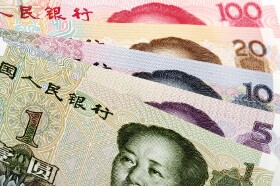
The Chinese yuan is strengthening against its US counterpart midweek, despite new data that shows the worldâs second-largest economy had a worse December than the market had anticipated. This is leaving some central bankers to forecast a slower-than-expected fourth-quarter, which is not something the nationâs leadership wants to hear as it ignites a wave of stimulus measures.
The Caixin/Markit Manufacturing Purchasing Managersâ Index (PMI) declined to 49.7 in December, down from 50.2 in November. A poll of private analysts had predicted the PMI to clock in at 50.1. Any reading above 50 indicates an expansion and anything below that threshold confirms a contraction.
The private survey also found that two different measures for new orders and new export orders signaled a contraction.
This comes as the official manufacturing PMI highlighted a slowdown in factory activity last month as the sector contracted for the first time since July 2016.
Investors are paying close attention to manufacturing data coming out of Beijing. Should economic data continue to highlight bearish trends in the coming weeks, then it would confirm that the ongoing trade dispute with the US is creating lasting effects for the Asian powerhouse.
Last month, the US-China entered a 90-day trade truce that postponed a planned increase of tariffs on $200 billion worth of Chinese goods. Recently, President Donald Trump confirmed that he had a âlong and very good callâ with his Chinese counterpart, President Xi Jinping. He noted that a trade deal between the two nations is progressing.
On Wednesday, China Finance Magazine, which is published by the Peopleâs Bank of China (PBOC), said that the countryâs economic growth in the October-to-December period could slip below 6.5% as the private sector faces new pressures.
The trend of economic slowdown still continues, and the slowing momentum is increasing. The fourth quarter GDP growth is very possible to be lower than 6.5 percent.
The phenomenon of closures and layoffs is very common and employeesâ income growth has been greatly restricted.
Researchers did note that tax cuts and ample liquidity could support the national economy.
The USD/CNY currency pair tumbled 0.24% to 6.8621, from an opening of 6.8785, at 16:07 GMT on Wednesday. The EUR/CNY cratered 1.42% to 7.7909, from an opening of 7.9031.
If you have any questions, comments or opinions regarding the Chinese Yuan,
feel free to post them using the commentary form below.